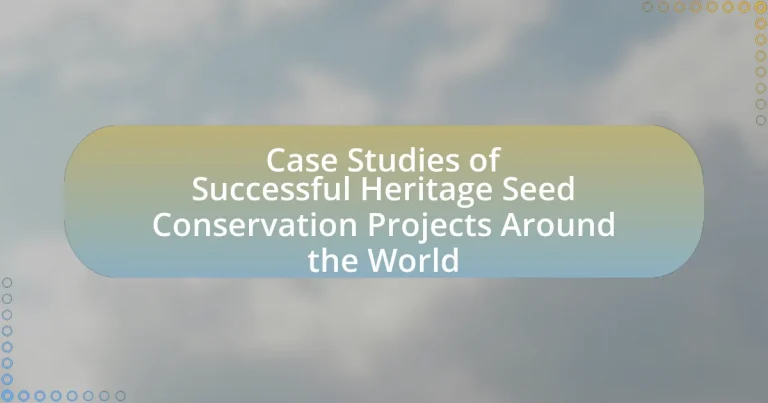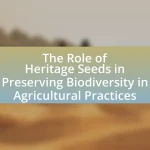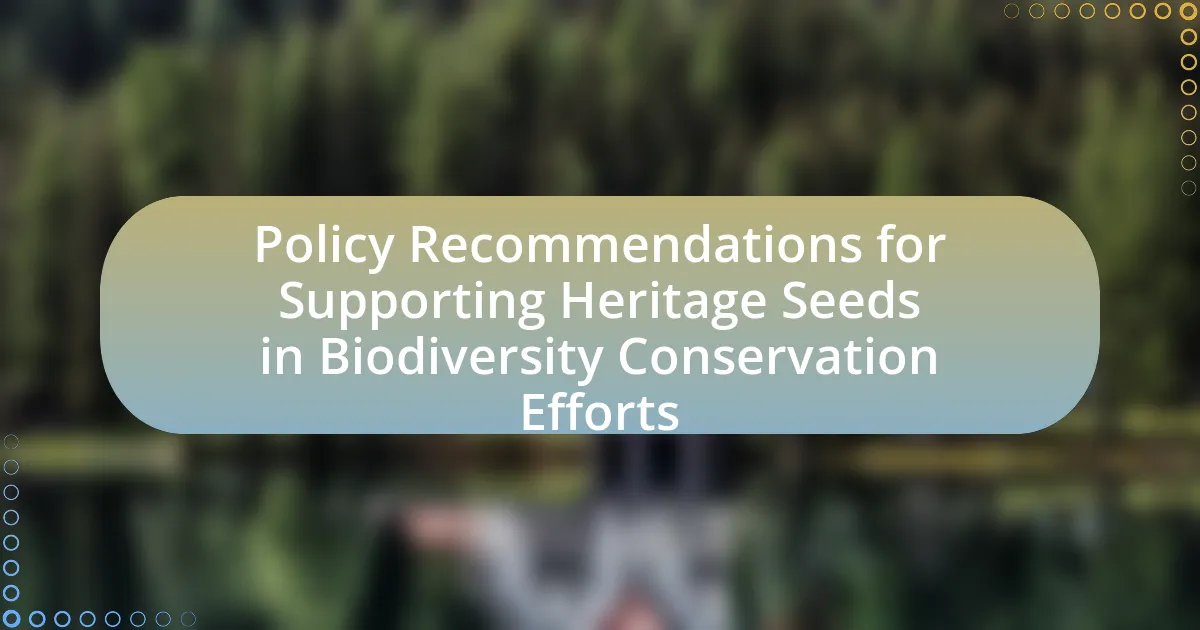Heritage Seed Conservation Projects are initiatives dedicated to preserving traditional seed varieties that have been cultivated over generations, emphasizing the importance of genetic diversity, sustainable agriculture, and cultural heritage. This article examines the significance of heritage seeds for biodiversity, their role in sustainable agriculture, and the challenges faced by conservation projects, including genetic erosion and funding limitations. It highlights successful projects worldwide, such as the Seed Savers Exchange and the Vavilov Institute, and discusses effective strategies for community engagement, education, and collaboration that enhance conservation efforts. Additionally, the article explores how socio-economic factors and technology influence these initiatives, providing insights into best practices for future heritage seed conservation.
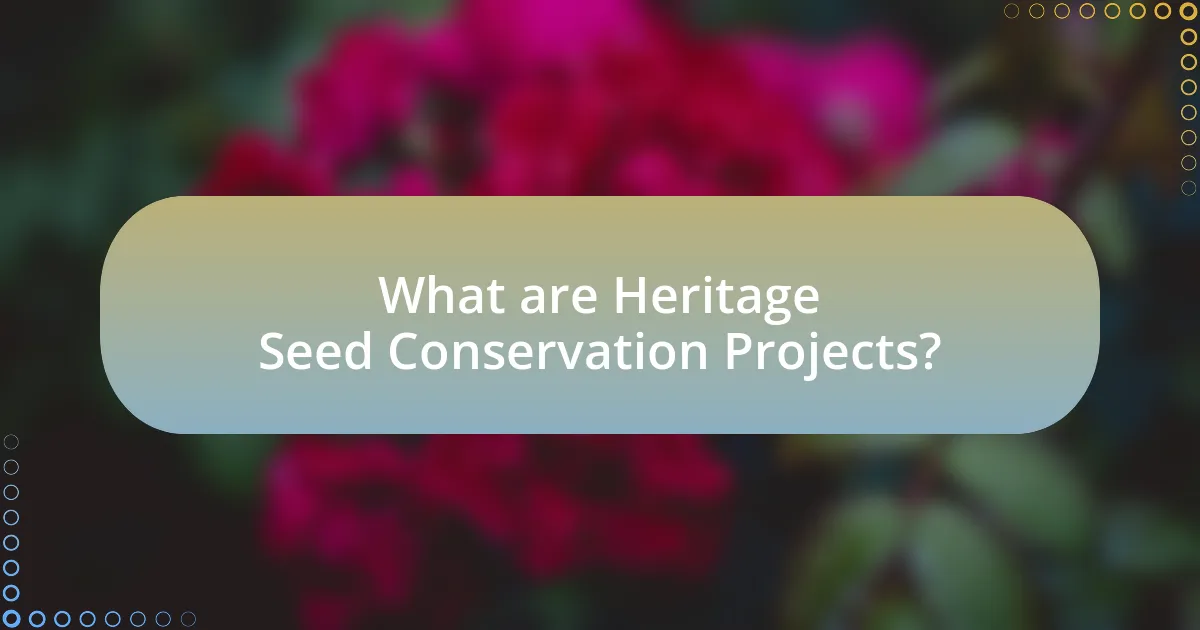
What are Heritage Seed Conservation Projects?
Heritage Seed Conservation Projects are initiatives aimed at preserving traditional seed varieties that have been cultivated over generations. These projects focus on maintaining genetic diversity, promoting sustainable agriculture, and protecting cultural heritage associated with specific crops. For example, the Seed Savers Exchange, founded in 1975, has successfully conserved thousands of heirloom seed varieties in the United States, demonstrating the importance of these projects in safeguarding biodiversity and supporting local farming communities.
Why are Heritage Seeds Important for Biodiversity?
Heritage seeds are important for biodiversity because they preserve genetic diversity within plant species, which is crucial for ecosystem resilience and adaptability. These seeds represent traditional varieties that have been cultivated over generations, often adapted to local climates and conditions. By maintaining a wide range of genetic traits, heritage seeds contribute to food security, as they can withstand pests, diseases, and changing environmental conditions better than modern hybrids. Studies have shown that diverse genetic resources can enhance agricultural productivity and sustainability, making heritage seeds vital for both ecological balance and agricultural resilience.
What role do heritage seeds play in preserving genetic diversity?
Heritage seeds play a crucial role in preserving genetic diversity by maintaining a wide range of plant varieties that have adapted to local environments over generations. These seeds represent unique genetic traits that can contribute to resilience against pests, diseases, and climate change. For instance, the Seed Savers Exchange, a nonprofit organization in the United States, has documented over 25,000 varieties of heritage seeds, showcasing the importance of these seeds in maintaining agricultural biodiversity. By cultivating and sharing heritage seeds, communities can ensure the survival of diverse genetic resources essential for food security and ecological stability.
How do heritage seeds contribute to sustainable agriculture?
Heritage seeds contribute to sustainable agriculture by preserving genetic diversity and promoting resilience in crops. These seeds, often adapted to local climates and conditions, enhance soil health and reduce the need for chemical inputs. For instance, studies show that heritage varieties can withstand pests and diseases better than modern hybrids, leading to lower pesticide use and improved ecosystem balance. Additionally, the use of heritage seeds supports local food systems and traditional farming practices, which are crucial for maintaining agricultural biodiversity.
What Challenges Do Heritage Seed Conservation Projects Face?
Heritage seed conservation projects face several significant challenges, including genetic erosion, funding limitations, and lack of public awareness. Genetic erosion occurs when traditional varieties are replaced by commercial hybrids, leading to a loss of biodiversity. Funding limitations hinder the ability to maintain seed banks and conduct research, as many projects rely on grants and donations that can be inconsistent. Additionally, a lack of public awareness about the importance of heritage seeds can result in insufficient community support and participation, which are crucial for the sustainability of these projects. These challenges collectively threaten the viability and effectiveness of heritage seed conservation efforts globally.
What are the main threats to heritage seed varieties?
The main threats to heritage seed varieties include loss of genetic diversity, industrial agriculture practices, climate change, and the commercialization of seeds. Loss of genetic diversity occurs as farmers increasingly rely on a limited number of high-yielding varieties, which diminishes the resilience of crops. Industrial agriculture practices often favor monocultures, leading to the neglect and eventual extinction of heritage varieties. Climate change poses risks through altered growing conditions, which can affect the viability of traditional seeds. Additionally, the commercialization of seeds, driven by large agribusiness companies, often results in the prioritization of patented seeds over heritage varieties, further threatening their existence.
How do socio-economic factors impact conservation efforts?
Socio-economic factors significantly impact conservation efforts by influencing funding availability, community engagement, and policy support. For instance, regions with higher economic resources can allocate more funds towards conservation initiatives, leading to better infrastructure and technology for preserving biodiversity. Additionally, communities with strong socio-economic ties are more likely to participate in conservation programs, as they see direct benefits to their livelihoods. Research indicates that areas with robust local economies often have higher success rates in conservation projects, as seen in the case of the Svalbard Global Seed Vault, which is supported by multiple nations due to its perceived global importance and the economic stability of its contributors.

What are Some Successful Heritage Seed Conservation Projects Worldwide?
Some successful heritage seed conservation projects worldwide include the Seed Savers Exchange in the United States, which has preserved over 25,000 heirloom varieties since its founding in 1975. Another notable project is the Vavilov Institute in Russia, which houses one of the largest seed banks globally, safeguarding thousands of plant species. Additionally, the Global Crop Diversity Trust works with various countries to conserve agricultural biodiversity, ensuring the preservation of traditional crop varieties. These projects demonstrate effective strategies for maintaining genetic diversity and promoting sustainable agriculture.
How Have Different Regions Implemented Heritage Seed Conservation?
Different regions have implemented heritage seed conservation through various strategies tailored to their unique agricultural practices and cultural contexts. For instance, in India, community seed banks have been established to preserve local varieties, allowing farmers to access and share seeds while promoting biodiversity. In the United States, organizations like Seed Savers Exchange focus on collecting and distributing heirloom seeds, fostering a network of gardeners dedicated to maintaining genetic diversity. In Europe, the European Union supports conservation through initiatives like the Agri-Environment Schemes, which incentivize farmers to cultivate traditional varieties. These approaches demonstrate a commitment to preserving agricultural heritage while addressing contemporary challenges such as climate change and food security.
What are notable projects in North America?
Notable projects in North America include the Seed Savers Exchange in Decorah, Iowa, which focuses on preserving heirloom seeds through community engagement and education. This organization has documented over 25,000 varieties of seeds, emphasizing the importance of biodiversity in agriculture. Another significant initiative is the Native Seeds/SEARCH in Tucson, Arizona, which works to conserve and distribute seeds of traditional crops from the Southwestern United States, supporting both cultural heritage and sustainable agriculture practices. These projects exemplify successful heritage seed conservation efforts, contributing to food security and ecological resilience in North America.
How have European initiatives contributed to heritage seed conservation?
European initiatives have significantly contributed to heritage seed conservation through programs like the European Union’s Agri-Environment Schemes and the European Cooperative Programme for Plant Genetic Resources. These initiatives promote the preservation of traditional varieties by providing financial support to farmers who cultivate heritage seeds, thereby incentivizing biodiversity. For instance, the EU’s funding mechanisms have enabled the establishment of seed banks and community seed networks, which facilitate the exchange and conservation of local seed varieties. Additionally, the European Commission’s Biodiversity Strategy aims to protect genetic resources, ensuring that heritage seeds are maintained for future generations.
What Strategies Have Proven Effective in These Projects?
Effective strategies in heritage seed conservation projects include community engagement, education, and collaboration with local farmers. Community engagement fosters a sense of ownership and responsibility, leading to increased participation in conservation efforts. Education initiatives raise awareness about the importance of biodiversity and traditional farming practices, which can enhance community support. Collaboration with local farmers ensures the preservation of indigenous knowledge and practices, as seen in projects like the Seed Savers Exchange in the United States, which has successfully maintained a diverse seed bank through farmer participation and knowledge sharing. These strategies have been validated by numerous case studies demonstrating improved seed diversity and community resilience.
How do community involvement and education enhance conservation efforts?
Community involvement and education significantly enhance conservation efforts by fostering local stewardship and increasing awareness of biodiversity’s importance. Engaging communities in conservation initiatives leads to a greater sense of ownership and responsibility towards local ecosystems, as evidenced by projects like the Seed Savers Exchange in the United States, which promotes the preservation of heirloom seeds through community participation. Educational programs that inform individuals about sustainable practices and the ecological value of heritage seeds have been shown to improve conservation outcomes, as demonstrated by the success of the Global Environment Facility’s Small Grants Programme, which empowers local communities to manage their natural resources effectively. These initiatives illustrate that when communities are educated and actively involved, they are more likely to implement and sustain conservation practices that protect biodiversity.
What role does technology play in successful heritage seed projects?
Technology plays a crucial role in successful heritage seed projects by enhancing seed preservation, improving genetic diversity, and facilitating data management. Advanced techniques such as cryopreservation allow for long-term storage of seeds, ensuring their viability over extended periods. Additionally, molecular markers and genomic sequencing enable the identification and preservation of genetic traits, which is vital for maintaining biodiversity. Furthermore, digital platforms and databases streamline the documentation and sharing of seed information, making it easier for farmers and researchers to access and utilize heritage seeds effectively. These technological advancements contribute to the sustainability and resilience of agricultural systems reliant on heritage seeds.
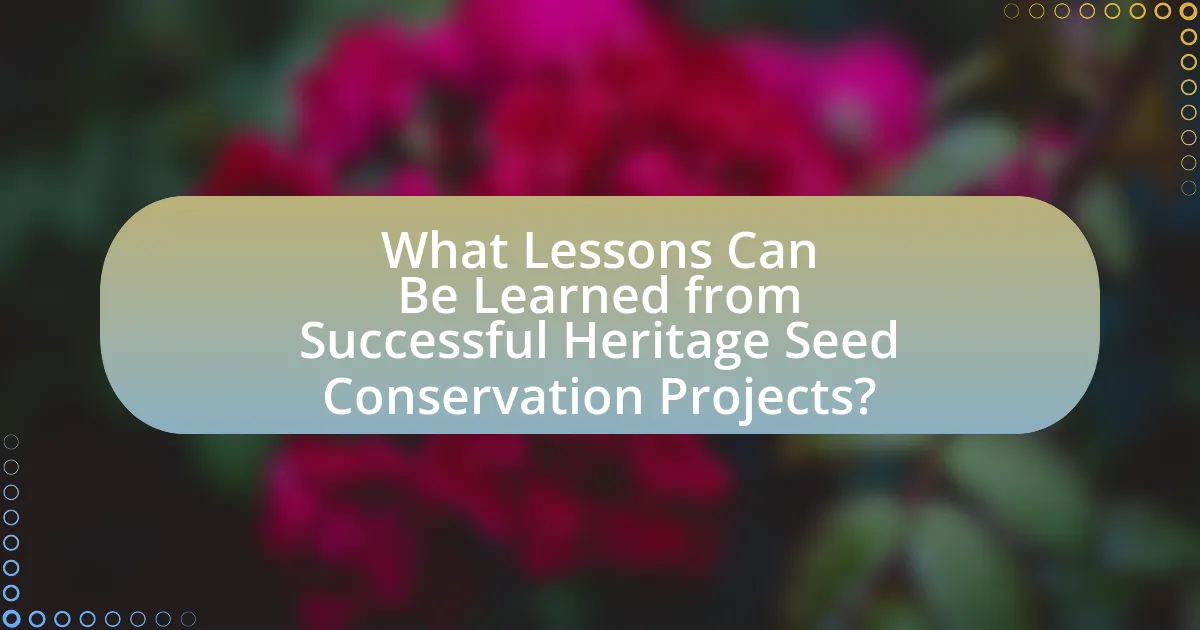
What Lessons Can Be Learned from Successful Heritage Seed Conservation Projects?
Successful heritage seed conservation projects demonstrate the importance of community involvement, biodiversity preservation, and sustainable agricultural practices. Community engagement fosters local ownership and ensures the transmission of traditional knowledge, as seen in projects like the Seed Savers Exchange in the United States, which has preserved thousands of heirloom varieties through grassroots efforts. Additionally, these projects highlight the significance of maintaining genetic diversity to enhance resilience against pests and climate change, evidenced by the success of the Svalbard Global Seed Vault, which safeguards a wide array of seeds from around the world. Lastly, implementing sustainable farming techniques, such as organic practices and crop rotation, has proven effective in maintaining soil health and productivity, as illustrated by the work of the Biodynamic Association in promoting heritage seeds.
What Best Practices Can Be Adopted for Future Projects?
Best practices for future heritage seed conservation projects include establishing strong community involvement, implementing rigorous documentation processes, and ensuring sustainable funding sources. Community involvement fosters local ownership and knowledge sharing, which are critical for the long-term success of conservation efforts. Rigorous documentation, as seen in successful projects like the Seed Savers Exchange, ensures that genetic information is preserved and accessible for future generations. Sustainable funding, demonstrated by initiatives such as the Global Crop Diversity Trust, secures resources necessary for ongoing conservation activities and research. These practices collectively enhance the effectiveness and sustainability of heritage seed conservation efforts.
How can collaboration between organizations improve outcomes?
Collaboration between organizations can significantly improve outcomes by pooling resources, expertise, and knowledge, which enhances the effectiveness of initiatives. For instance, in heritage seed conservation projects, partnerships between NGOs, governmental bodies, and local communities have led to increased biodiversity preservation and sustainable agricultural practices. A study by the Food and Agriculture Organization (FAO) highlights that collaborative efforts in seed conservation can result in a 30% increase in seed diversity and improved resilience against climate change. This demonstrates that when organizations work together, they can achieve more impactful results than when operating independently.
What are the key factors for sustainability in heritage seed conservation?
The key factors for sustainability in heritage seed conservation include genetic diversity, community involvement, and effective management practices. Genetic diversity ensures resilience against pests and diseases, as demonstrated by the success of the Svalbard Global Seed Vault, which preserves a wide variety of seeds to safeguard against global agricultural threats. Community involvement fosters local stewardship and knowledge transfer, as seen in the Seed Savers Exchange in the United States, where local farmers actively participate in seed saving and sharing. Effective management practices, such as proper storage conditions and regular monitoring, are crucial for maintaining seed viability, as evidenced by the practices employed by the Millennium Seed Bank in the UK, which focuses on long-term seed preservation strategies.
How Can Individuals Contribute to Heritage Seed Conservation Efforts?
Individuals can contribute to heritage seed conservation efforts by participating in seed saving, educating others about the importance of biodiversity, and supporting local seed banks. Seed saving involves collecting and preserving seeds from heirloom plants, which helps maintain genetic diversity and ensures the availability of these varieties for future generations. Education plays a crucial role, as individuals can raise awareness about the significance of heritage seeds in sustainable agriculture and food security. Supporting local seed banks, which often rely on community involvement for donations and volunteer work, further strengthens these conservation efforts. According to the Seed Savers Exchange, over 1 million varieties of seeds have been preserved through community efforts, highlighting the impact of individual contributions in maintaining agricultural biodiversity.
What actions can gardeners take to support heritage seed preservation?
Gardeners can support heritage seed preservation by actively participating in seed saving, which involves collecting and storing seeds from heirloom plants for future planting. This practice not only maintains genetic diversity but also ensures the continuation of traditional varieties that may be at risk of extinction. According to the Seed Savers Exchange, a non-profit organization dedicated to preserving heirloom seeds, gardeners can contribute by growing a variety of heritage plants, sharing seeds with local communities, and educating others about the importance of biodiversity in agriculture. By doing so, they help sustain agricultural heritage and promote food security.
How can consumers influence the market for heritage seeds?
Consumers can influence the market for heritage seeds by actively choosing to purchase and promote these seeds, thereby creating demand that encourages farmers and retailers to prioritize their cultivation and sale. When consumers opt for heritage seeds, they support biodiversity and traditional agricultural practices, which can lead to increased availability in the market. For instance, the rise in consumer interest in organic and locally sourced foods has been linked to a resurgence in heritage seed varieties, as seen in various community-supported agriculture (CSA) programs and farmers’ markets. This trend demonstrates that consumer preferences can directly impact agricultural practices and seed diversity, reinforcing the importance of heritage seeds in sustainable farming.
